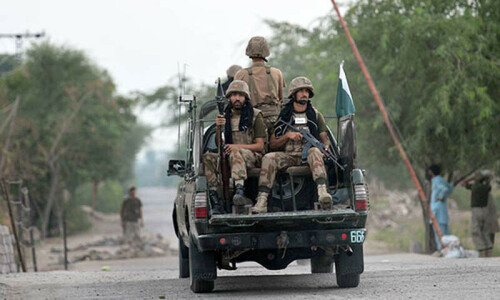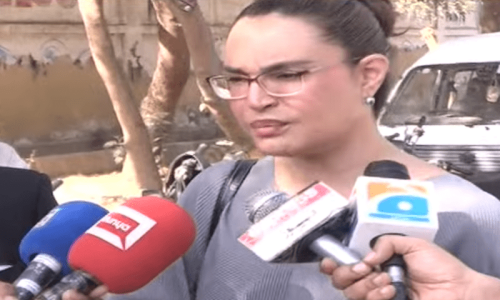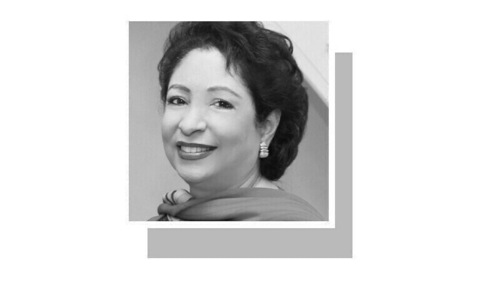Ousted prime minister Nawaz Sharif, his daughter Maryam Nawaz and son-in-law retired Captain Mohammad Safdar appeared before an accountability court in Islamabad for a hearing in connection with the corruption references filed against them by the National Accountability Bureau (NAB).
In a break from tradition, all three members of the Sharif family arrived at the court in the same car. The motorcade carrying the trio comprised 30 vehicles, DawnNews reported.

The court heard arguments from Sharif's counsel Khawaja Haris and NAB prosecutor about merging the three corruption references against the accused. The court reserved its decision and adjourned the hearing till Wednesday (tomorrow).
The former premier, his daughter and son-in-law left the court after the counsel completed his arguments.
The counsel for Sharifs stayed inside the court as NAB prosecution presented its arguments on the matter after a 15-minute break.
Arguments about clubbing references
While arguing for the consolidation of the three corruption references, Haris read out the charge-sheets from the corruption cases.
He said the charges levelled against the Sharifs are common in all three references. The references relate to different assets but all three name the same persons as accused.
The counsel said that nine and 13 witnesses have been named in the Flagship Investment Ltd reference and Al-Azizia Steel Mills reference, respectively. Six witnesses are common in both references and three are common with those of Avenfield flats reference, he observed.
If the same witness is allowed to testify in multiple references, he or she will get time to prepare as they would know what questions the defence counsel is likely to ask and they might alter their statement accordingly, he argued.
Haris pleaded that while three references could remain, a single trial should be held against the accused. If they are found guilty after trial of the central reference, one sentence should be announced.
He said the court had the authority to continue with the proceedings after merging the references, adding that under the law, an accused could not be punished for a crime multiple times.
The counsel said several paras of the three references are common but none of the references state the allegations against the accused.
He claimed that the Supreme Court-sanctioned Joint Investigation Report had stated that the London flats were owned by the Sharif family but it did not directly name any individuals.
The references state that Sharif's sons, Hassan and Hussain, had no sources of income until 2001, but they are silent on who is the real owner of the London properties.
He said multiple trials conducted on the same charges would not be transparent.
Giving references of past cases, the counsel said the court had merged 49 references in the Nato containers case.
Sharif had arrived in the country from London amid VIP protocol to appear before the accountability court last Friday.
However, the hearing against Sharif, his daughter and son-in-law had adjourned after an order passed the previous day by the Islamabad High Court (IHC) regarding the clubbing of three references against the Sharif family could not be procured by the court in time.
NAB prosecutor argues against merging references
NAB prosecutor Wasiq Malik argued against the petition to club the three references, saying every case has its own facts.
He said the primary benamidar (front man) in the Flagship Investment Ltd reference is Hassan Nawaz while that in Al-Azizia Steel Mills reference is Hussain Nawaz.
The references were separated due to different crimes and transactions but the primary accused is common in all three references, he said.
Each accused has an individual role in each asset and in the Al Azizia reference, the prosecutor said. He said that while only one transaction came to Pakistan in the Flagship reference, multiple transactions came to the country in Al Azizia reference.
He argued that while the witnesses are indeed common in three references, they have to provide different documents for the case record.
Malik further said the cases could not be merged on the application of a single accused (Nawaz) when two accused (Hassan and Hussain) have not joined the proceedings.
'Court will need to indict Sharif, Maryam and Safdar again'
At the outset of the proceedings on Friday, Judge Mohammad Bashir said he had read in a newspaper that the IHC had ordered clubbing of three corruption references together.
At this, NAB deputy prosecutor general Sardar Muzaffar Abbasi said the IHC had not passed such an order, but remanded the matter to the accountability court again.
After receiving the IHC short order issued on Nawaz Sharif’s petitions seeking a joint trial of all the three references, the judge then read out the order sheet, according to which the accountability court was asked to examine the matter in the light of Section 17-D.
The section reads: “A person accused of more offences than one of the same kind…may be charged with and tried at one trial for any number of such offences.”
Haris, the counsel for Sharif, argued that in case the references were clubbed together, the court would need to indict Sharif, Maryam and Safdar again.
NAB references
A five-member bench of the Supreme Court on July 28 had directed NAB to file references against Nawaz and his children in six weeks in the accountability court and directed the trial court to decide the references within six months.
The Supreme Court also assigned Justice Ijazul Ahsan a supervisory role to monitor the progress of the accountability court proceedings.
NAB had filed three references on Sept 8 against Sharif and his family, and another reference against Finance Minister Ishaq Dar. The three references against the Sharif family are related to the Flagship Investment Ltd, the Avenfield (London) properties and Jeddah-based Al-Azizia Company and Hill Metal Establishment.
The former premier and his sons, Hassan and Hussain, have been named in all three NAB references, while Maryam and husband Safdar have been named only in the Avenfield reference.
















































